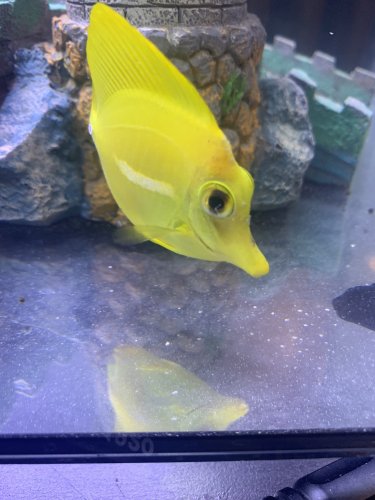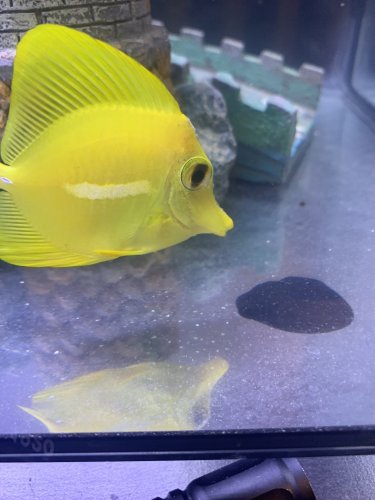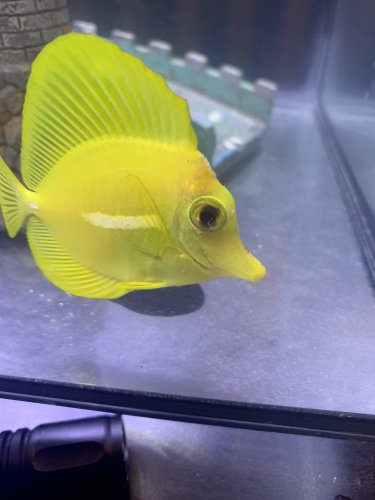Below is a list of difficult fish to quarantine, with specific recommendations on QT strategies for each group of fish.
Moorish Idol
This is actually an easy fish to QT if you can just get it eating. They are tolerant of most medications and not overly susceptible to many diseases.
QT strategy: Similar to a Copperband, try offering brine, mysis, blackworms, clam, oyster, etc. However, unlike most butterflies a Moorish Idol is omnivorous so you can also try feeding nori in QT. (Soak nori in RODI water if medication(s) are being used, so it absorbs the taste of that and not the medication.) Keep in mind that Moorish Idols have very high metabolisms and thus require multiple daily feedings.
Puffers, Lionfish, Eels and other copper intolerant species
Relatively easy to quarantine, but these fish do not always tolerate copper well.
QT strategy: Puffers will sometimes do OK in chelated copper (e.g. Copper Power). However, puffers, lions and other copper intolerant species do best if treated with Chloroquine phosphate. Hyposalinity (aka Osmotic Shock Therapy) is another option for puffers, but it only treats Ich + Flukes.
Seahorses/Pipefish
Intolerant of copper and (probably) Chloroquine as well. Seahorses are prone to gas bubble disease and certain bacterial infections.
QT strategy: Seahorses do best at temperatures of 70-74F, which discourages harmful bacteria from propagating. They are susceptible to infections which can afflict their snout, tail and gut. Triple Sulfa & Furan-2 are two recommended antibiotics to use. Diamox is the best medication to keep on hand for treating gas bubble disease, and an insulin syringe with a 26-gauge needle can be used to release excess gas from a male's pouch. I've seen Bio-Bandage (Neonmycin-based topical gel) recommended for lacerations.
Pipefish are relatively hardy, but like seahorses do best in a low flow environment. Both seahorses & pipefish are ideal candidates for: Black Molly Quarantine
Sharks, stingrays and eels
Scaleless fish which are intolerant of copper.
QT strategy: Chloroquine phosphate is the treatment of choice for eliminating ectoparasites found on these fish. Dimilin or Dylox can be used to deworm / remove parasites with an exoskeleton found on sharks & rays.
Tangs (primarily Acanthurus spp.)
We've all heard about how "hard" Achilles & Powder Blue Tangs are to keep. They're not. However, they do require a parasite free environment (due to their thin slime coat) and strong water flow for increased oxygen (they are typically collected in crest zones).
QT strategy: Point a powerhead (or run an air stone on high) towards the surface of the water in order to create a disturbance/ripple effect. This will increase gas exchange and infuse more dissolved oxygen into the water. It's also a good idea to prophylactically treat with copper or Chloroquine, in order to eradicate any ich/velvet they may be carrying.
Wrasses (Fairy, Flasher & Leopards) ** Prolific tank jumper, so use a secure lid **
There's a reason they are sometimes referred to as "pain in my wrasse". These fish flat out don't like being in quarantine; especially a rockless, bare bottom environment. They are prone to flukes and internal parasites/intestinal worms. Wrasses are not a big fan of most medications (so take care never to overdose with them.)
QT strategy: Since these fish prefer to lay on sand sometimes (Leopards will burrow), it is advisable to have an area of sand in the QT for them. (Sand in a glass Pyrex bowl works.) You definitely want to deworm all wrasses using praziquantel. Fairy wrasses, Leopards, Halichoeres spp, Anampses spp, Labroides spp, Thalassoma spp, Pseudocheilinops spp tolerate Chloroquine well; Flashers, Coris spp & Pseudocheilinus spp DO NOT. When using copper, most wrasses seem to do better in chelated copper (e.g. Copper Power) than ionic (e.g. Cupramine). Regardless of brand, raise copper very slowly (4-5 days) when treating wrasses.
To deal with the internal problems (you'll see white stringy poo if internal parasites/worms are present), soak food with API General Cure or Fenbendazole for 10-14 days. Seachem Focus can be used to bind the medication to the food.
Being a "pain in the wrasse" qualifies you for: Black Molly Quarantine
Moorish Idol
This is actually an easy fish to QT if you can just get it eating. They are tolerant of most medications and not overly susceptible to many diseases.
QT strategy: Similar to a Copperband, try offering brine, mysis, blackworms, clam, oyster, etc. However, unlike most butterflies a Moorish Idol is omnivorous so you can also try feeding nori in QT. (Soak nori in RODI water if medication(s) are being used, so it absorbs the taste of that and not the medication.) Keep in mind that Moorish Idols have very high metabolisms and thus require multiple daily feedings.
Puffers, Lionfish, Eels and other copper intolerant species
Relatively easy to quarantine, but these fish do not always tolerate copper well.
QT strategy: Puffers will sometimes do OK in chelated copper (e.g. Copper Power). However, puffers, lions and other copper intolerant species do best if treated with Chloroquine phosphate. Hyposalinity (aka Osmotic Shock Therapy) is another option for puffers, but it only treats Ich + Flukes.
Seahorses/Pipefish
Intolerant of copper and (probably) Chloroquine as well. Seahorses are prone to gas bubble disease and certain bacterial infections.
QT strategy: Seahorses do best at temperatures of 70-74F, which discourages harmful bacteria from propagating. They are susceptible to infections which can afflict their snout, tail and gut. Triple Sulfa & Furan-2 are two recommended antibiotics to use. Diamox is the best medication to keep on hand for treating gas bubble disease, and an insulin syringe with a 26-gauge needle can be used to release excess gas from a male's pouch. I've seen Bio-Bandage (Neonmycin-based topical gel) recommended for lacerations.
Pipefish are relatively hardy, but like seahorses do best in a low flow environment. Both seahorses & pipefish are ideal candidates for: Black Molly Quarantine
Sharks, stingrays and eels
Scaleless fish which are intolerant of copper.
QT strategy: Chloroquine phosphate is the treatment of choice for eliminating ectoparasites found on these fish. Dimilin or Dylox can be used to deworm / remove parasites with an exoskeleton found on sharks & rays.
Tangs (primarily Acanthurus spp.)
We've all heard about how "hard" Achilles & Powder Blue Tangs are to keep. They're not. However, they do require a parasite free environment (due to their thin slime coat) and strong water flow for increased oxygen (they are typically collected in crest zones).
QT strategy: Point a powerhead (or run an air stone on high) towards the surface of the water in order to create a disturbance/ripple effect. This will increase gas exchange and infuse more dissolved oxygen into the water. It's also a good idea to prophylactically treat with copper or Chloroquine, in order to eradicate any ich/velvet they may be carrying.
Wrasses (Fairy, Flasher & Leopards) ** Prolific tank jumper, so use a secure lid **
There's a reason they are sometimes referred to as "pain in my wrasse". These fish flat out don't like being in quarantine; especially a rockless, bare bottom environment. They are prone to flukes and internal parasites/intestinal worms. Wrasses are not a big fan of most medications (so take care never to overdose with them.)
QT strategy: Since these fish prefer to lay on sand sometimes (Leopards will burrow), it is advisable to have an area of sand in the QT for them. (Sand in a glass Pyrex bowl works.) You definitely want to deworm all wrasses using praziquantel. Fairy wrasses, Leopards, Halichoeres spp, Anampses spp, Labroides spp, Thalassoma spp, Pseudocheilinops spp tolerate Chloroquine well; Flashers, Coris spp & Pseudocheilinus spp DO NOT. When using copper, most wrasses seem to do better in chelated copper (e.g. Copper Power) than ionic (e.g. Cupramine). Regardless of brand, raise copper very slowly (4-5 days) when treating wrasses.
To deal with the internal problems (you'll see white stringy poo if internal parasites/worms are present), soak food with API General Cure or Fenbendazole for 10-14 days. Seachem Focus can be used to bind the medication to the food.
Being a "pain in the wrasse" qualifies you for: Black Molly Quarantine




